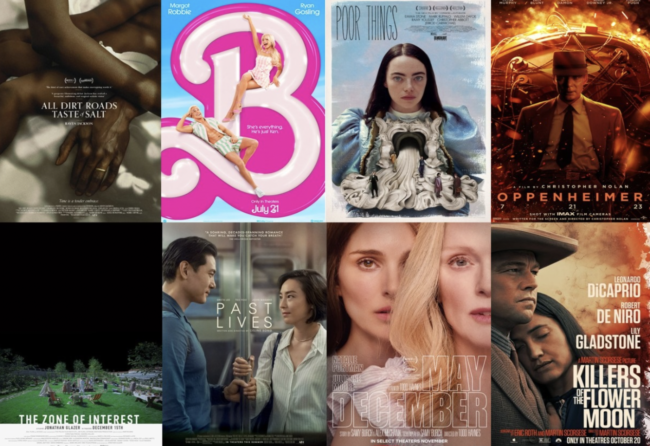From the moment Thomas Edison’s kinetoscope allowed for the photographic capture of objects in motion, movies became the cornerstone of the human artistic experience. With the capacity to imagine new worlds, portray diverse narratives and comment on the status quo, movies make us feel and experience the most visceral stories. And save for the golden age of Hollywood, no era has been as prevalent for movies as the current one.
After what has felt like a steady trend of each awards season entailing a handful of standout films and not much else, the past year proved enthralling for avid moviegoers. Perhaps this is because of the unique positionality of many films’ creative processes. With the average movie taking around 2.5 years to reach theaters, it is safe to assume the ideas for 2023 releases had their origins in the wake of the pandemic. Many auteurs’ pandemic brainchilds were the culmination of being isolated with their genius for an extended period of time. Creatives left to their own devices and boredom had merely one option: to create. And create they did.
The year 2023 got off to a slower start. Picking up in March with the release of the action movie “John Wick: Chapter 4” and the moving fictional portrait of addiction entitled “A Good Person,” the first picture that truly brought audiences to theaters was the live-action version of “The Little Mermaid” released in May. With Halle Bailey portraying Princess Ariel, the film was a milestone that gave way to larger conversations about the importance of representation in art and media.
Then, there was the box-office sensation that is “Barbenheimer.” The rare coming-together of two films so excellent and so different presented a rather unique experience. Crowds dressed in hues of pink readied themselves for an empowerment-filled picture of Barbie and feminism. Then, with the tune of “What Was I Made For?” by Billie Eilish permeating their minds, flocked to adjacent theaters for a three-hour sensory dive into the storied tale of physicist (and Fieldston alum) Robert Oppenheimer. The whole spectacle reinstated a tangible joy in the act of going to the movies.
Even for those far from considering themselves cinephiles, the powerhouse duos of Christopher Nolan and Cillian Murphy for “Oppenheimer” and Greta Gerwig and Margot Robbie for “Barbie” alongside strong ensemble casts worked to make the experience of watching both films feel like a conscious, active consumption of art. All the more, the movies were emotionally evocative, but in vastly different ways. As “Barbie” interrogated all that the doll and in turn women stand for and experience, “Oppenheimer” masterfully told the story of the physicist Oppenheimer’s scientific values being at odds with his personal ones and the moral cost of the Manhattan Project. Consisting of the two movies of the summer, “Barbenheimer” was an era in and of itself.
Some other notable mentions for the summer include “Bottoms” starring the ever-iconic Ayo Edebiri and Rachel Sennot, Neil Blomkamp’s “Gran Turismo” about the life of driver James Mardenborough and celebrated animation “Spider-Man: Across the Spider-Verse.” However as the leaves changed, so did the titles below the “Now Showing” signs at local theaters.
Fall was undoubtedly the season of “Priscilla,” “Killers of the Flower Moon” and an uptick in Tom Blythe obsessions following the release of “The Hunger Games: The Ballad of Songbird and Snakes.” It felt as though every week of the September- November stretch brought news of a must-see. This constant flow of movies from esteemed directors like Sofia Coppola and Martin Scorsese made the season an exhilarating one. Said directors pushed their own creative envelopes to bring crowds something new to take in.
Winter arrived, and as did the popularity of another film that is soon to extend beyond its cult classic status and into the canon of quintessential holiday movies. Paul Giamatti and first-time actor Dominic Sessa captivated the attention and hearts of audiences as they portrayed a grumpy but inevitably lovable teacher and his precocious but standoffish student in “The Holdovers.” Set in the 1970s and filmed as such, the picture is the type of movie that makes one stop and think “they don’t make films like this anymore.” A touching character-driven narrative set in the winter break tundra of East Coast boys’ boarding school “Barton Academy” with a brief plot stint in Boston, Giamatti’s “Mr. Munham” is assigned “holdover” duty watching over the students left behind for the holidays. When the majority of the bunch leave for a ski trip and the number dwindles to one, Angus Sully, audiences get a glimpse into the heartfelt interactions between Sully, Munham and grieving mother Mary Lamb portrayed by Da’Vine Joy Randolph.
Winter was also the age of “The Iron Claw,” romcom fan favorite “Anyone but You” and Yorgos Lanthimos’ masterful “Poor Things.”
Fundamentally, it is the range of films that has made this moment in movie history especially poignant. It feels as though each story is being given proper license to be told and received. Just as life imitates art and art life, the creativity of film releases this year has compounded as creativity mirrors creativity. We are fortunate to live in a time of such strong visual storytelling and no medium does this better than movies.
With Oscars season being the next to approach, the moment feels appropriate to take a pause (ranging from one to three and a half hours) to appreciate some of the extraordinary cinematic works dominating theaters right now. It takes not only filmmakers and talented casts and crews to conjure movie magic, but dedicated fans and audience members willing to let themselves fall under the spell of great cinema.







Wonderful article. Interesting, well written, and insightful.. it makes me want to go to the movies!